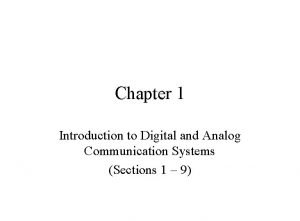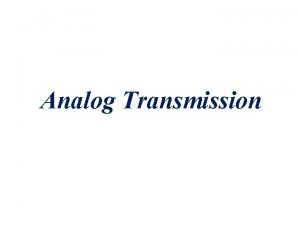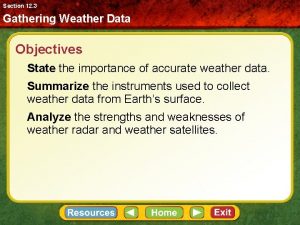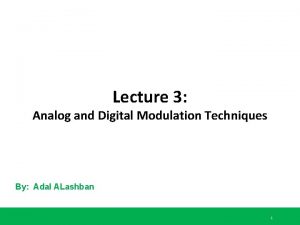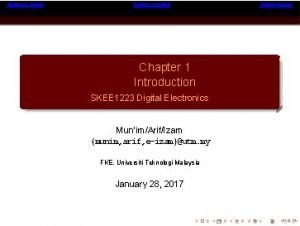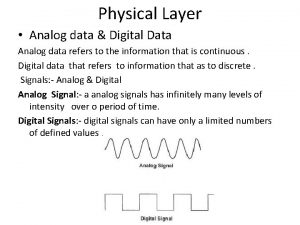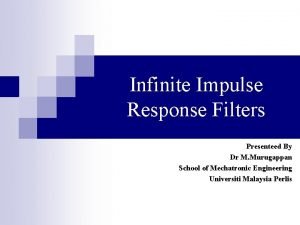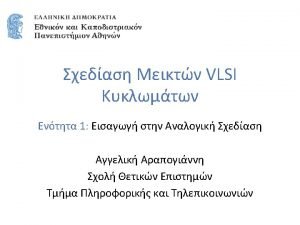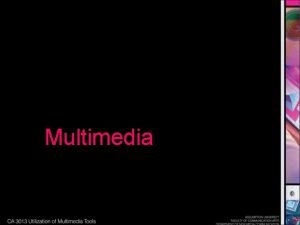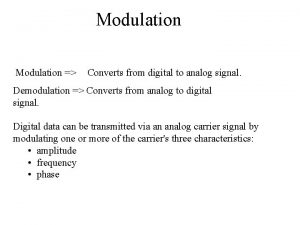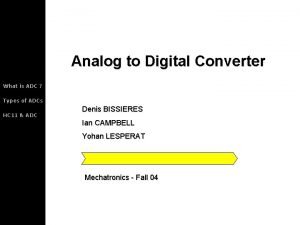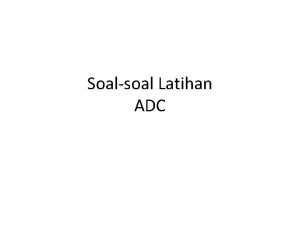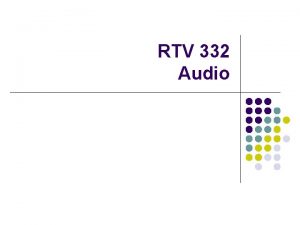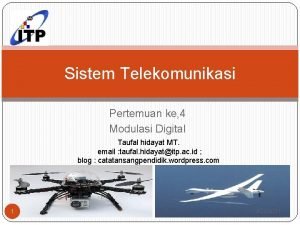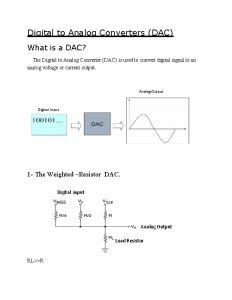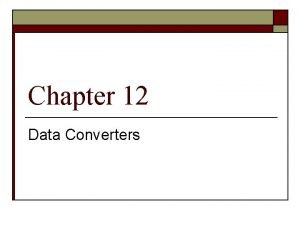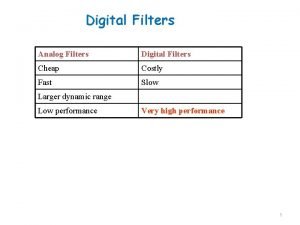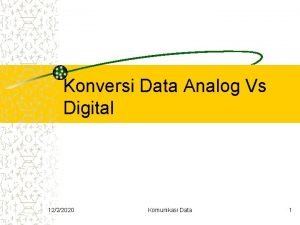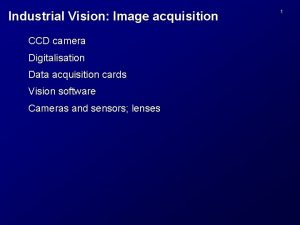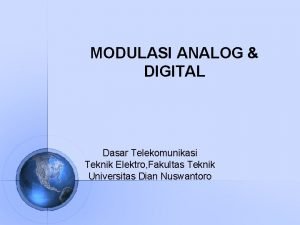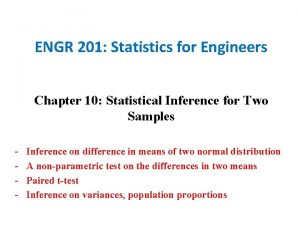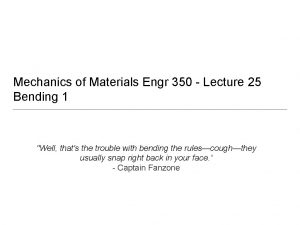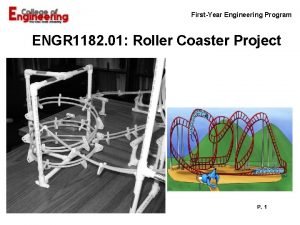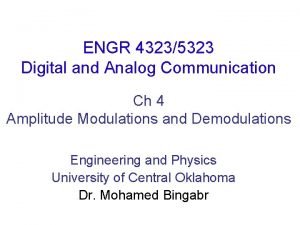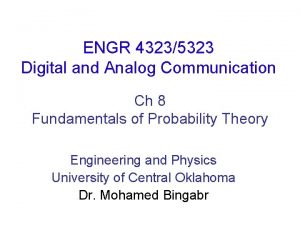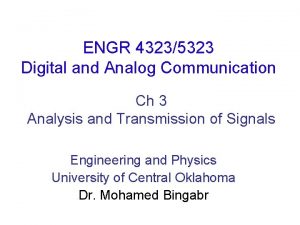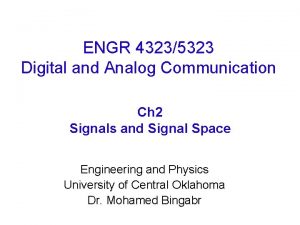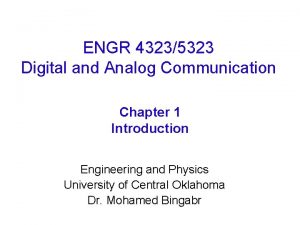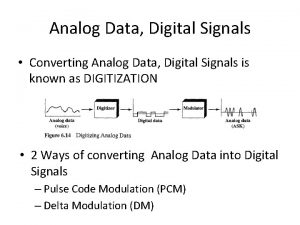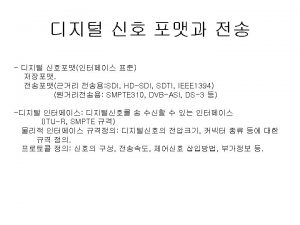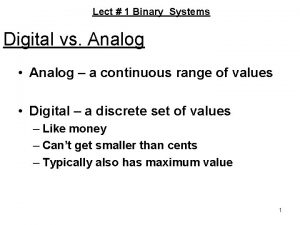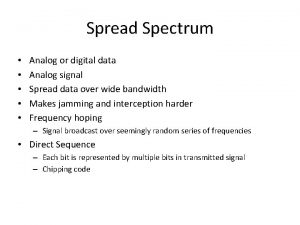ENGR 43235323 Digital and Analog Communication Ch 7










































- Slides: 42

ENGR 4323/5323 Digital and Analog Communication Ch 7 Principles of Digital Data Transmission Engineering and Physics University of Central Oklahoma Dr. Mohamed Bingabr

Chapter Outline • Digital Communication Systems • Line Coding • Pulse Shaping • Scrambling • Digital Receiver and Regenerative Repeaters • PAM: M-ARY Baseband Signaling for Higher Data Rate • Digital Carrier Systems • M-ARY Digital Carrier Modulation 2

Digital Communication Systems On-Off (RZ) Polar (RZ) Line Coding Bipolar (RZ) On-Off (NRZ) Polar (NRZ) 3

Digital Communication Systems Digital Carrier Modulation Multiplexer - Amplitude Modulation - Time Division - Frequency Modulation - Frequency Division - Phase Modulation - Code Division 4

Digital Communication Systems Regenerative Repeater - Used at regularly spaced interval. - Timing information extracted from the received signal. - Transparent line code does not effect the accuracy of the timing information. 5

Line Coding Property of Line Code - Transmission Bandwidth - Power Efficiency - Error Detection and Correction Capacity - Favorable Power Spectral Density - Adequate Timing Content - Transparency 6

PSD of Line Codes The PSD will depend on the line code pattern x(t) and the pulse shape p(t). 7

PSD of Line Codes We can express the impulse as a pulse with narrow width and large amplitude such that the strength of the pulse is the same as the impulse. 8

PSD of Line Codes 9

PSD of Line Codes Again Rn is 10

PSD of Polar Signaling For rectangular pulse shape 11

PSD of Polar Signaling - Essential Bandwidth 2 Rb Hz - No capability for error detection or correction - Nonzero PSD at dc ( f = 0) - For a given power, Polar signaling has the lowest error detection probability. - Transparent - Rectification of polar signal can help in extracting clock timing. 12

Constructing a DC Null in PSD by Pulse Shaping Split-phase (Manchester or twinned-binary) signal. Fig. a: Basic pulse p(t) for Manchester signaling. Fig. b: Transmitted waveform for binary data sequence using Manchester signaling. Read On-Off Signaling 13

PSD of Bipolar Signaling Half the time a. K equals 0 and the other half time equals either 1 or -1. For R 1, the combination of akak+1 = 11, 10, 01, 00. For bipolar rule the product is zero for the last three combination and -1 for the first combination. 14

PSD of Bipolar Signaling 15

PSD of Bipolar Signaling - Essential Bandwidth Rb Hz. - Single error detection capability. - Zero PSD at dc ( f =0). - Disadvantage require twice the power as a polar signal needs. - It is not transparent. 16

High-Density Bipolar (HDB) Signaling The HDB scheme is an ITU standard. In this scheme the problem of nontransparency in bipolar signaling is eliminated by adding pulses when the number of consecutive 0 s exceeds N. (a) HDB 3 signal and (b) its PSD. 17

Pulse Shaping The pulse shape p(t) effect the PSD Sy( f ) more than the choice of line code. Intersymbol Interference (ISI): Spreading of a pulse beyond its allocated time interval Tb will cause it to interfere with neighboring pulses. 18

Nyquist 1 st criteria for Pulse Shaping Nyquist criteria for pulse shaping to eliminate ISI: Pulse shape that has a nonzero amplitude at its center and zero amplitudes at t = n. Tb (n =1, 2, 3, …) 19

Nyquist 1 st criteria for Pulse Shaping

Nyquist 2 nd criteria for Pulse Shaping Pulse broadening in the time domain leads to reduction of its bandwidth. Pulse satisfying second criteria is also knowing as the duobinary pulse. Information Sequence 1 1 0 0 0 1 1 1 Samples y(k. Tb) 1 2 0 0 2 0 -2 -2 0 0 0 2 2 Detected sequence 1 1 0 0 0 1 1 1

Nyquist 2 nd criteria Duobinary Pulse The minimum bandwidth pulse that satisfies the duobinary pulse criterion and (b) its spectrum.

Scrambling Scrambler tends to make the data more random by removing long strings of 1 s and 0 s. Removing long 0 s or 1 s help in timing extraction. However, the main purpose of scrambling is to prevent unauthorized access to the data.

Scrambling Example The data stream 10100000111 is fed to the scrambler. Find the scrambler output T, assuming the initial content of the registers to be zero.

Scrambling Example The data stream 10100000111 is fed to the scrambler. Find the scrambler output T, assuming the initial content of the registers to be zero. S 1 2 3 4 5 T 1 0 0 0 1 0 0 0 1 0 0 1 1 1 1 0 1 1 1 0 1 1 1 0 0 0 1 1 1 0 0 0 1 1 1 0 1 0 0 0 1 1 0 0 T=101110001101001 0 0 1 1 0 0 1

Digital Receivers and Regenerative Repeaters Tasks of Receivers or repeaters: 1. Reshaping incoming pulses by means of an equalizer. 2. Extracting the timing information required to sample incoming pulses. 3. Making symbol detection decisions based on the pulse samples.

Time Extraction Three general methods of synchronization 1 - Derivation from a primary or a secondary standard (transmitter and receiver slaved to a master timing source). 2 - Transmitting a separate synchronizing signal (pilot clock) 3 - Self-synchronization, where the timing information is extracted from the received signal itself.

Eye Diagrams: An Important Tool Three general methods of synchronization Eye diagrams of a polar signaling system using a raised cosine pulse with roll-off factor 0. 5: over 2 symbol periods 2 Tb with a time shift Tb/2;

PAM: M-ARY Baseband Signaling for Higher Data Rate The information IM transmitted by an M-ary symbol is The transmitted power increases as M 2.

Example Determine the PSD of the quaternary (4 -ary) baseband signaling when the message bits 1 and 0 are equally likely.

Digital Carrier Systems In transmitting and receiving digital carrier signals, we need a modulator and demodulator to transmit and receive data. The two devices, modulator and demodulator are usually packaged in one unit called a modem for two-way (duplex) communication. Amplitude Shift Keying (ASK) (a) The carrier cos ωct. (b) The modulating signal m(t). (c) ASK: the modulated signal m(t) cos ωct.

Digital Carrier Systems (Modulator) Phase Shift Keying (PSK) Frequency Shift Keying (FSK)

Spectrum of Modulated Digital Signals PSD of ASK PSD of PSK PSD of FSK

Digital Carrier Systems (Demodulator) Noncoherent detection of FSK Coherent binary PSK detector

Differential PSK (DPSK) DPSK allows noncoherent demodulation at the receiver. The transmitter encodes the information data into the phase difference θk - θk-1. For example a phase difference of zero represent 0 whereas a phase difference of signifies 1. Transmitter Encoding Receiver Decoding

Differential PSK (DPSK) Transmitter Encoding Receiver Decoding

M-Ary Digital Carrier Modulation Higher bit rate transmission can be achieved by either reducing Tb or by applying M-ary signaling; the first option requires more bandwidth; the second requires more power to keep the error bit rate within acceptable level. M-ary shift keying can send Log 2 M bits each time by transmitting any one of M signals. M-ary ASK and noncoherent Detection M-ary FSK and noncoherent Detection

Choice of the Frequencies for FSK

Comparison between ASK and FSK does not require increase in power but the bandwidth increase linearly with M (compared with binary FSK or M-ary ASK). ASK does not require increase in bandwidth but the power increase linearly with M.

M-ary PSK M-ary PSK symbols in the orthogonal signal space: (a) M = 2; (b) M = 4; (c) M = 8.

M-ary PSK M-ary PSK symbols in the orthogonal signal space: (a) M = 2; (b) M = 4; (c) M = 8.

Quadrature Amplitude Modulation (QAM) p(t) is a properly shaped baseband pulse. A simple choice is a rectangular. 16 -point QAM (M = 16). QAM or Multiplexing
 Analog vs digital communication systems
Analog vs digital communication systems Digital to analog conversion in data communication
Digital to analog conversion in data communication Compare and contrast analog and digital forecasts.
Compare and contrast analog and digital forecasts. Compare and contrast analog and digital forecasting
Compare and contrast analog and digital forecasting Analog and digital modulation techniques
Analog and digital modulation techniques Analog and digital video
Analog and digital video Digital vs analog signal
Digital vs analog signal Analog vs digital
Analog vs digital Analog image and digital image
Analog image and digital image Analog and digital signals in computer networking
Analog and digital signals in computer networking Analog vs digital chips
Analog vs digital chips Digital and analog quantities
Digital and analog quantities Introduction to digital control
Introduction to digital control Analog and digital video in multimedia
Analog and digital video in multimedia Analog data and digital data
Analog data and digital data Compare analog and digital filters
Compare analog and digital filters Digital control
Digital control Analog and digital difference
Analog and digital difference Apa yang dimaksud teknologi digital
Apa yang dimaksud teknologi digital Analog vs digital
Analog vs digital Modulation digital to analog
Modulation digital to analog Amw huebsch
Amw huebsch Adc types
Adc types Analog to digital converter
Analog to digital converter Pengertian adc dan dac
Pengertian adc dan dac Contoh soal sinyal kontinyu
Contoh soal sinyal kontinyu Digital vs analog sound
Digital vs analog sound Digital signal as a composite analog signal
Digital signal as a composite analog signal Kelebihan dan kekurangan modulasi digital
Kelebihan dan kekurangan modulasi digital Digital to analog converter
Digital to analog converter Digital to analog converters basic concepts
Digital to analog converters basic concepts Analog encoding
Analog encoding Tap digital
Tap digital Analog vs digital
Analog vs digital Alat elektronik yang menggunakan konsep elektronika analog
Alat elektronik yang menggunakan konsep elektronika analog Digital image acquisition for analog sem
Digital image acquisition for analog sem Modulasi analog dan digital
Modulasi analog dan digital Engineering 1181
Engineering 1181 Sjsu engineering 10
Sjsu engineering 10 Engr 201
Engr 201 Engr 1182
Engr 1182 Engr 350
Engr 350 Engr 1182
Engr 1182
